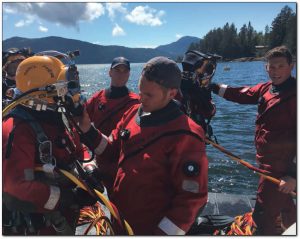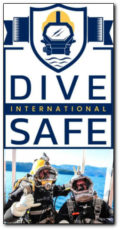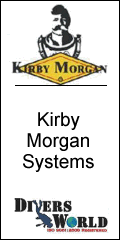NEW CSA DIVE STANDARDS DEFAULTS TO MINIMUM 4 PERSON CREW ON ALL DIVE OPERATIONS.
By CADC Admin ~ December 3rd, 2019. Filed under: Latest Diving News, Safety, Standards and Regulations.
 With the new release of Z275.2-20 (Diving Operations) in effect Jan 2020, the Canadian Standards emphasizes the default use of a minimum four-person crew to be required on all occupational diving operations – with only rare exceptions possibly allowed under a completed onsite risk assessment. The key to crew size is the this completed onsite risk assessment.
With the new release of Z275.2-20 (Diving Operations) in effect Jan 2020, the Canadian Standards emphasizes the default use of a minimum four-person crew to be required on all occupational diving operations – with only rare exceptions possibly allowed under a completed onsite risk assessment. The key to crew size is the this completed onsite risk assessment.
SURFACE SUPPLIED DIVING MINIMUM CREW REQUIREMENTS
For all surface supplied diving operations, the requirements in the standard states:
8.2.1 Minimum crew (SURFACE SUPPLIED DIVING)
For each surface-supplied diving operation, a minimum dive team of four shall be present in the following capacities:
- a) two crew members shall be divers, one of whom shall act as a standby diver.
- b) one crew member shall be a diver’s tender: and
- c) one crew member shall be the diving supervisor.
Again – as in any diving operation – the minimum crew size would be determined by an onsite risk assessment / Job Safety Analysis (JSA). The minimum crew default is four competent personnel to be onsite and present during the operation.
SCUBA DIVING MINIUMUM CREW REQUIREMENTS
A SCUBA diving operation in an occupational diving environment is prohibited under the following conditions:
SCUBA diving operations CANNOT be used in operations that include.
- Offshore Oil and Gas diving operations.
- Diving Operations involving underwater intakes, and/or entry into pipes or other penetration diving or closed space.
- SCUBA shall not be used for diving operations that involve
- a) welding.
- b) burning/cutting;
- c) high-pressure jetting.
- d) hoisting
- e) dredging.
- f) the use of power tools.
- g) planned diving beyond the no-decompression limit;
- h) diving in a contaminated environment (with an exception of diving in Category 3 where the use of SCUBA is permitted in specific conditions and subject to minimum requirements for diver’s dress and equipment as identified in the standard) NOTE: Five person crew is the minimum in a contaminated environment)
- i) the use or handling of explosives [with the exception of the clearance/remediation of unexploded explosive ordnance (UXO), provided that a hazard assessment has determined that the use of surface supply diving techniques and equipment would lead to an increased risk and specific tasks associated with police diving or improvised explosive devices (IEDs)]. For UXO and police diving operations, see CSA Z275.6.
- water depths in excess of 30 m (99ft) except in an emergency.
If the diving operation does NOT include any of the above noted restrictions, then SCUBA can be used and the minimum crew requirement in the standard will be as follows:
7.5 4 Minimum crew (SCUBA DIVING OPERATIONS)
7.5.1
For each SCUBA diving operation, a minimum dive team of four shall be present in the following capacities (see exceptions specified in Clause 7.5.2)
- a) two crew members shall be divers, one of whom shall act as a standby diver;
- b) one crew member shall be a diver’s tender; and
- c) one crew member shall be the diving supervisor.
A 4-person crew shall only be used where an on-site completed risk assessment indicates that any known hazards will not impact the safe use of a 4-person crew.
The rare exception in to consider reduction of the crew size and NOT using the default 4-person crew is as follows:
7.5.2
For each SCUBA diving operation, a minimum crew of three workers may be present on each dive site under the following conditions
- a) on which diving will not exceed 18 m (60 ft) in depth;
- b) on which diving will remain within the no-decompression limit;
- c) on which diving will be conducted in a location where it is known that no hazard of entrapment exists; and
- d) where an on-site completed risk assessment indicates that any known hazards will not impact the safe use of a 3-person crew.
The key phrase here in the new upcoming Z275.2-20 (Dive Operations) is that a completed (ie: “written down and signed”) on-site risk assessment indicating that any known hazards on a jobsite will not impact the SAFE use of a 3 person crew. This implies that the job hazard analysis could identify that conditions MIGHT allow the use of a three-person crew – and that it also determine that that a larger crew size may need to be used to mitigate risk.
In both cases, the dive supervisor and his crew are directed to conduct an onsite and completed JOB HAZARD ANALYIS that is to include compulsory items noted below;
| HAZARD ANALYSIS COMPULSARY ITEMS | YES | NO | NOTES |
| Has a risk & hazard analysis been carried out, discussed and signed off by all staff? | |||
| Have measures been taken and documented to address and mitigate risks? | |||
| Is the crew size appropriate to address and mitigate risks? | |||
| Have all aspects of an emergency plan been identified and tested? | |||
| Is the crew size adequate to address rescue and recovery? |
Another point – and it is an important one – is that in any diving operation (including the use of SCUBA) – is the requirement that this hazard analysis worksheet is to be COMPLETED (ie: written down and signed – and on the jobsite) before operations begin.
The dive supervisor – having conducted and filled out a COMPLETED risk assessment of the known hazards regardless of the mode of diving used – is responsible for the safety of his operation and is accountable.
Accountable means that should there be an incident or accident, it is the dive supervisor that would be held accountable and responsible to explain and justify their choice of crew size based on the risk assessment. It is a serious responsibility. Failure to comply to protect and deal with worker safety concerns under Canadian Bill C-45 is a criminal offense. Criminal offense includes the option of jail time if convicted.
A diligent safety inspector or client should ask when reviewing procedures for any diving operation – either surface supplied or SCUBA – is to scrutinise the COMPLETED risk assessment prepared by the supervisor of the dive procedure. It ensures that due diligence has been done in considering all known hazards to the health and safety of the workers.
That first step simply begins with counting the number of workers onsite for the diving operation. If there are not four or more competent workers on the dive site, it would be prudent to ask for the hazard analysis worksheet and ask the question “Why are there not a minimum of four competent personnel on your crew?”
The answer to this question by the supervisor will give insight as to their commitment and competence focusing on the safety of the workers under his control.
It is imperative that all diving operations be built on safety first.






